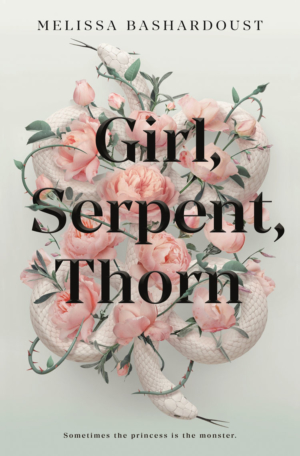Can you remember where and when you first got the idea for Girl, Serpent, Thorn?
Story ideas are strange, because sometimes they come to you in pieces, and sometimes they come to you all at once. I had been brainstorming writing something based on ‘Sleeping Beauty’ for a while, looking in particular at the thematic similarities between aspects of Sleeping Beauty and the short story ‘Rappaccini’s Daughter’. One night when I was trying to fall asleep, I was thinking about the good fairy/bad fairy dichotomy in Sleeping Beauty and the way it could work in the frame of Persian folklore, which has a similar divide between malevolent demons and benevolent fairies. I started to tell myself the story that ended up becoming the prologue, using what I knew of Persian folklore to reimagine the backstory of Sleeping Beauty’s curse – and that was the beginning of Girl, Serpent, Thorn!
What were your inspirations while writing the novel?
The novel takes inspiration from the stories in the 11th century Persian epic, the Shahnameh. The Shahnameh is meant to be a history of the Ancient Persian Empire, but the first two-thirds are drawn from myth rather than history. There are great heroes and magical birds and fearsome demons, along with feuding family members, kings both good and evil, and a story that sounds a lot like ‘Rapunzel’. I wanted to use this mixture of myth and history to create the world of the novel, and borrowed some of the key figures and creatures from the Shahnameh along the way. For those who want to know more, Girl, Serpent, Thorn has an Author’s Note with more detail on individual stories and further resources!
It seems very significant that our protagonist Soraya is poisonous – it makes her both powerful and isolated…
I was interested in exploring the idea of a heroine who was both powerful and powerless at the same time. I was drawn to that element in Sleeping Beauty—the sleeping princess surrounded/protected by dangerous thorns—and also the idea of an isolated, poisonous girl in Rappaccini’s Daughter. I wanted to explore that dynamic more deeply, to look at what it would mean for a girl in a dangerous world to have that kind of protection. I also liked the idea of this literal poison that could reflect the kinds of poisonous thoughts or impulses that we all succumb to at times, and the ways Soraya has to come to terms with each of these kinds of poison.
The novel’s love triangle adds in some interesting dynamics between the three main characters – why did you include this element?
Honestly, I really love the drama of a love triangle, so it was fun to write! But I also wanted Soraya to be presented with different possible paths in response to the choices she and others have made. Those two characters appeal to Soraya in different ways, and speak to different fears and hopes in her as she tries to sort out her own feelings. By having her drawn to both of those characters, she’s essentially weighing and evaluating different parts of herself and deciding which to nurture and which to root out.

The main antagonists in the novel are the ‘divs’ who all have different looks and traits. How did you choose each type of div?
I looked at illustrations of divs in the Shahnameh and saw that many of them have animalistic features such as horns or tusks and claws, so I mostly based the divs’ appearance on certain animals. In particular, I decided to use animals that are considered predatory or poisonous, because these were the animals considered malevolent or evil in Zoroastrian tradition. For the pariks, I chose nocturnal, winged animals in particular because the pariks are based on the pari or peri (meaning ‘fairy’), who traditionally have wings.
There seems to be an underlying theme of outward appearances masking the truth of the characters on the inside – was this an intentional theme?
I’m not even sure how intentional this was on my part, but I love playing with archetypes, especially fairy tale archetypes. I wanted to present characters who appeared to fit into clear roles based on stories we’re familiar with, and then subvert or complicate those roles over the course of the story. I’m afraid to say more without spoiling anything!
There is an emphasis on botany within Girl, Serpent, Thorn – Soraya finds comfort in her garden and in the woods. What were your inspirations for this?
Many of the sources I was drawing on involve flowers or plant life in some way — like the thorny rose briars of Sleeping Beauty, the poisonous garden of Rappaccini’s Daughter and the walled gardens of Ancient Persia — so I always knew that roses and gardens would feature heavily in this story. And I liked the idea of giving Soraya something living that she could touch and tend to without killing. The forest that features in the novel takes inspiration from the Hyrcanian forest in the north of Iran near the Caspian Sea—I was amazed to see photos of this lush rainforest in an area we normally associate with dry deserts, and so wanted to incorporate it in a meaningful way.
The main characters are all very complex – our heroes have flaws and our villains have aspects that are relatable. How did you approach creating these characters and do you have a favourite?
I always try to approach characters with empathy — to figure out why they’re making these choices, what factors are motivating them, what they’re most afraid of. We all make mistakes, and we all have flaws, so the question for me is why did this character make that mistake, and how do they choose to respond to it?
I have affection for all of my characters, but I think my favourite is Soraya — with a special mention to her mother, Tahmineh — because she’s the one who carried me through each draft of this book. Her story is what I most wanted to tell.
What are you reading right now?
Right now, I’m reading The Vanishing Half by Brit Bennett, and next up is Mexican Gothic by Silvia Moreno-Garcia.
What’s next for you?
I have a short story based on The Winter’s Tale in the Shakespeare-inspired anthology, That Way Madness Lies (edited by Dahlia Adler), which is released in March 2021. It includes, perhaps unsurprisingly, a lot of family drama and a lot of trees.
